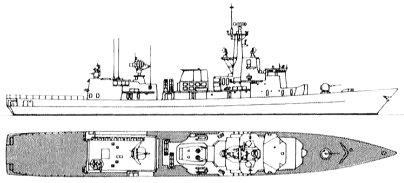
NAVYPEDIA
 Support the project with paypal
Support the project with paypal
Photo

Van Speijk 2002 Many thanks to Wolfgang Stöhr for additional information on this page.
Ships
| Name | No | Yard No | Builder | Laid down | Launched | Comm | Fate |
|---|---|---|---|---|---|---|---|
| Karel Doorman (ex-Groningen) | F827 | 364 | KM De Schelde, Vlissingen | 26.2.1985 | 20.4.1988 | 31.5.1991 | to Belgium 12.2005 (Leopold I) |
| Willem van der Zaan (ex-Friesland) | F829 | 365 | KM De Schelde, Vlissingen | 6.11.1985 | 21.1.1989 | 28.11.1991 | to Belgium 12.2005 (Louise-Marie) |
| Tjerk Hiddes (ex-Utrecht) | F830 | 366 | KM De Schelde, Vlissingen | 28.10.1986 | 9.12.1989 | 26.2.1993 | to Chile 3.2004 (Almirante Riveros) |
| Van Amstel | F831 | 367 | KM De Schelde, Vlissingen | 3.5.1988 | 19.5.1990 | 27.5.1993 | in service (2019) |
| Abraham van der Hulst | F832 | 368 | KM De Schelde, Vlissingen | 8.2.1989 | 7.9.1991 | 15.12.1993 | to Chile 3.2004 (Blanco Encalada) |
| Van Nes | F833 | 369 | KM De Schelde, Vlissingen | 10.1.1990 | 16.5.1992 | 24.6.1994 | to Portugal 1.2009 (Bartolomeu Dias) |
| Van Galen | F834 | 370 | KM De Schelde, Vlissingen | 7.6.1990 | 21.11.1992 | 1.12.1994 | to Portugal 11.2009 (D. Francisco de Almeida) |
| Van Speijk | F828 | 371 | KM De Schelde, Vlissingen | 1.10.1991 | 26.3.1994 | 7.9.1995 | in service (2019) |
Technical data
| Displacement standard, t | 2800 |
|---|---|
| Displacement full, t | 3320 |
| Length, m | 114.4 pp 122.3 oa |
| Breadth, m | 14.4 |
| Draught, m | 4.30 hull 6.05 propellers |
| No of shafts | 2 |
| Machinery | F827: CODOG: 2 Rolls-Royce Spey RM-1A gas turbines / 2 Werkspoor-Wärtsilä 12SW 280V12 diesels F828-834: CODOG: 2 Rolls-Royce Spey RM-1C gas turbines / 2 Werkspoor-Wärtsilä 12SW 280V12 diesels |
| Power, h. p. | F827: 37530 / 9800 F828-834: 48900 / 9800 |
| Max speed, kts | F827: 29 F828-834: 30 |
| Fuel, t | gas turbine oil |
| Endurance, nm(kts) | 5000(18) |
| Armament | 2 x 4 Harpoon SSM (8 RGM-84C), 1 x 16 Sea Sparrow SAM (VLS, 16 RIM-7M), 1 x 1 - 76/62 OTO Melara Compact, 1 x 7 - 30/77 Goalkeeper, 2 x 1 - 20/70 Mk 10, 4 - 324 Mk 32 mod. 9 TT (Mk 46 mod. 5), 1 helicopter (SH-14D Sea Lynx) |
| Electronic equipment | F827: type 1007, Scout, LW-08, 2x STIR-18, Goalkeeper radars, PHS-36 sonar, AR700 ECM suite, 2x Mk 36 SRBOC decoy RL, SLQ-25 Nixie torpedo decoy, SEWACO VIIA CCS F829: type 1007, Scout, LW-08, 2x STIR-18, Goalkeeper radars, PHS-36 sonar, AR700 ECM suite, 2x Mk 36 SRBOC decoy RL, SLQ-25 Nixie torpedo decoy, SEWACO VIIB CCS F830, 831: type 1007, Scout, SMART-S, LW-08, 2x STIR-18, Goalkeeper radars, PHS-36 sonar, AR700 ECM suite, 2x Mk 36 SRBOC decoy RL, SLQ-25 Nixie torpedo decoy, SEWACO VIIB CCS F828, 832-834: type 1007, Scout, SMART-S, LW-08, 2x STIR-18, Goalkeeper radars, PHS-36, DSBV-61 Anaconda sonars, AR700, 2x APECS II ECM suites, 2x Mk 36 SRBOC decoy RL, SLQ-25 Nixie torpedo decoy, SEWACO VIIB CCS |
| Complement | 154 |
Standard scale images

Van Nes 2000

Van Amstel 2015
Graphics
Project history
This class was originally intended to replace the six elderly US-built frigates of the Roofdier class. Four ships were to have been built, and the design was essentially a scaled-down version of the 'Standard' frigate, with a standard displacement of 1900t and a length overall of 111.8m. Intended to operate primarily in the North Sea, the ships were to be fitted for peacetime surveillance and fishery protection duty, but were to be capable of operating with the 'Standard' in the North Atlantic in the antisubmarine role.
With the completion of the 'Standard' construction programme there was a crisis at the De Schelde Shipyard, and in order to provide continuity of work the first batch was ordered three years earlier than planned. The contract was signed in June 1985, after the first hull had been laid down. Contracts for the weapons, electronics and command systems were placed later in the same year. A further four ships were ordered in April 1986 to replace the frigates of the Van Speijk class, which were retired early to finance the programme.
The final design is significantly larger, the lengthened stern section reflecting the decision to provide hangar flight deck facilities for a helicopter larger than the Lynx. To port of the hangar are vertical launch tubes for NATO Sea Sparrow, which have replaced the conventional eight-cell box launcher. Other changes reflect the lessons of the Falklands crisis and advances in electronics. In particular, the original DAISY computer bank has been superseded by a combat system based around a triple Ethernet-based databus, which allows the physical distribution of processors and databases over the whole area of the ship. The sides of the hull and superstructure have been angled to maximize radar discretion, and a passive 'rudder-roll' stabilization system is fitted in place of the traditional fins.
Otherwise the ships reflect many of the original requirements. Three semi-rigid inflatables are carried for boarding ships and oil rigs, and there is accommodation for a detachment of 30 marines. Extensive automation has enabled the crew size to be reduced to 154 officers and men.
The decision to order the ships earlier than planned has resulted in the hulls being ready in advance of much of their equipment. KareI Doorman was completed with the less powerful Spey SM-1A gas turbine, and has run trials lacking the SMART 3-D radar, the US Argo APECS II EW suite, and the Thomson-CSF DSBV-61 Anaconda towed array.
Modernizations
1992, Karel Doorman, Willem van der Zaan: + SMART-S radar
early 1990s, Karel Doorman, Willem van der Zaan, Tjerk Hiddes, Van Amstel: + 2x APECS-II ECM suites
2004, all: - 2 x 1 - 20/70; + 2 x 1 - 12.7/90
2012, Van Speijk: - 1 helicopter (SH-14D Sea Lynx), DSBV-61 Anaconda sonar, SEWACO VIIB CCS; + 1 helicopter (NH 90), Gatekeeper e/o system, IRFLAS sonar, SEWACO XI CCS
2014, Van Amstel: - 1 helicopter (SH-14D Sea Lynx), SEWACO VIIB CCS; + 1 helicopter (NH 90), Gatekeeper e/o system, IRFLAS sonar, SEWACO XI CCS
Naval service
No significant events.
 HOME
HOME FIGHTING SHIPS OF THE WORLD
FIGHTING SHIPS OF THE WORLD NETHERLANDS
NETHERLANDS ESCORTS
ESCORTS KAREL DOORMAN frigates (1991-1995)
KAREL DOORMAN frigates (1991-1995)
